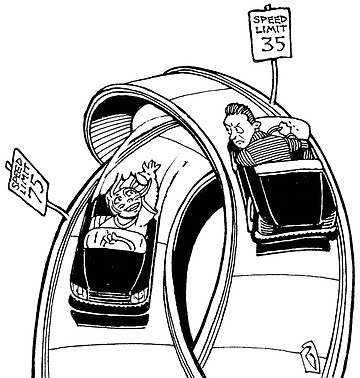 Facebook
Facebook
 X
X
 Instagram
Instagram
 TikTok
TikTok
 Youtube
Youtube

Heymatt:
Why do some local roadways have different speed limits depending on which way you’re going? Seaworld Drive between Friars and Ingraham is 55 in one direction and 50 in the other. West Point Loma Boulevard between Nimitz and Adrian Street is 40 one way and the other direction is 35. I can never remember which way is what speed. I’m afraid I’ll get nailed for speeding after a wrong guess. The correct answer is not, “Just go the same speed as the other traffic,” since there are lots of speeding, aggressive yahoos mixed in with slow, clueless tourists out there. This makes no sense to me. Traffic volumes and road conditions are the same on both sides of both roadways, as far as I can tell. Is there a logical reason for this or does the entrenched, right-wing city power structure just want to make life hard for OBecians?
— Brent, Ocean Beach

Despite the fact that the government refuses to legalize Ocean Beach’s national pastime, it’s unlikely the powers that be have it out for you when it comes to speed limits. These stretches of road with disparate speed limits are rare, but they do happen and they are perfectly legal. Speed limits are calculated according to a formula whereby traffic officials measure the mean speed of traffic on a given roadway and then set the limit within five mph. of the 85th percentile of that speed. In short, they put it on the high side of average. This usually works out to a nice medium between the “speeding, aggressive yahoos” and the “slow, clueless tourists.” Occasionally, because of features in the roadway, the flow of traffic in opposing directions will differ by more than five mph, which is when those funky, oppositional speed limits happen. In the case of Sea World Drive, it’s probably because Sea World slows traffic significantly in one direction. If you look at West Point Loma Boulevard on a map, you’ll see that the roadway is developed differently on both sides. Traffic entering and exiting no doubt affects the average speed of drivers, which causes the directional imbalance.


Heymatt:
Why do some local roadways have different speed limits depending on which way you’re going? Seaworld Drive between Friars and Ingraham is 55 in one direction and 50 in the other. West Point Loma Boulevard between Nimitz and Adrian Street is 40 one way and the other direction is 35. I can never remember which way is what speed. I’m afraid I’ll get nailed for speeding after a wrong guess. The correct answer is not, “Just go the same speed as the other traffic,” since there are lots of speeding, aggressive yahoos mixed in with slow, clueless tourists out there. This makes no sense to me. Traffic volumes and road conditions are the same on both sides of both roadways, as far as I can tell. Is there a logical reason for this or does the entrenched, right-wing city power structure just want to make life hard for OBecians?
— Brent, Ocean Beach

Despite the fact that the government refuses to legalize Ocean Beach’s national pastime, it’s unlikely the powers that be have it out for you when it comes to speed limits. These stretches of road with disparate speed limits are rare, but they do happen and they are perfectly legal. Speed limits are calculated according to a formula whereby traffic officials measure the mean speed of traffic on a given roadway and then set the limit within five mph. of the 85th percentile of that speed. In short, they put it on the high side of average. This usually works out to a nice medium between the “speeding, aggressive yahoos” and the “slow, clueless tourists.” Occasionally, because of features in the roadway, the flow of traffic in opposing directions will differ by more than five mph, which is when those funky, oppositional speed limits happen. In the case of Sea World Drive, it’s probably because Sea World slows traffic significantly in one direction. If you look at West Point Loma Boulevard on a map, you’ll see that the roadway is developed differently on both sides. Traffic entering and exiting no doubt affects the average speed of drivers, which causes the directional imbalance.
Comments